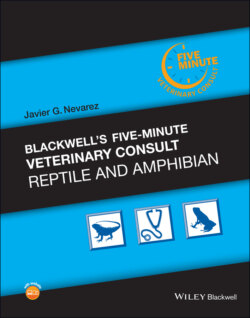Читать книгу Blackwell's Five-Minute Veterinary Consult: Reptile and Amphibian - Javier G. Nevarez - Страница 20
BRUMATION
ОглавлениеBrumation is the process by which a reptile reduces its metabolism and becomes dormant during the winter. As opposed to hibernation in mammals, brumating reptiles may retain a low level of activity, wake up to drink water and then go back into dormancy. The stimulus for and emergence from brumation is primarily influenced by temperature, but other factors, including reproduction and food availability, may also play a role. There are four stages of brumation:
1 A decrease in temperature leads to inhibition of appetite.
2 Reptiles seek a hibernaculum that provides insulation against freezing and enough moisture. Oxygen availability is less important.
3 Fat stores (liver, fat bodies, tail) are used as energy source, especially when emergence occurs in the spring.
4 Emergence from brumation is triggered by an increase in temperature with photoperiod having little to no influence since most brumate underground. During this period a reptile should not lose more than 10% of their body weight.
Captive reptiles undergoing brumation should be weighed on a bi‐monthly schedule to monitor their weight. It is critical that water be available during brumation in captivity to avoid dehydration. Brumating reptiles can be soaked weekly to every other week.
Estivation is a period of inactivity during the dry season, mostly used by desert species in an effort to conserve water. Some turtles may leave the water during periods of drought and bury themselves on land until the conditions are favorable again. This is less likely to occur in captivity since a constant water source is available.
